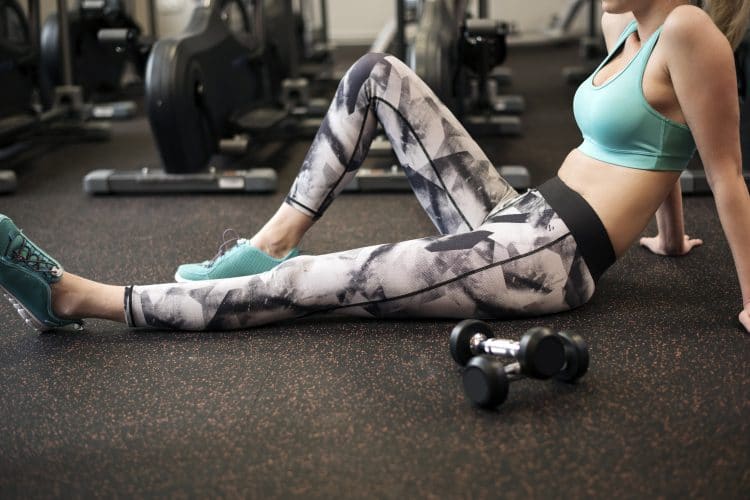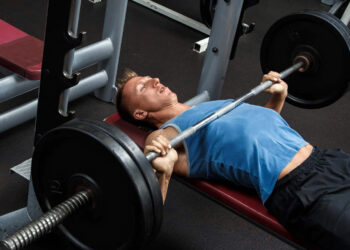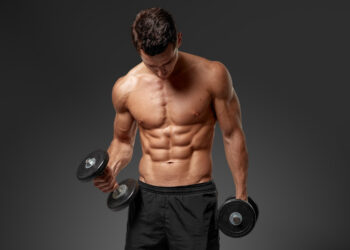There are dozens, if not hundreds, of ways to organize your workout schedule. You can train anywhere from twice to six or more times per week, working each body part just once or multiple times. You can follow a full-body workout plan or break things up and do a split routine. The options are almost endless.
Contrary to popular opinion, there is no “perfect” training split or workout routine, and almost every program will produce results if you commit to it and train consistently. Keep hitting the gym, and your body will adapt, assuming you are eating right and getting enough sleep, of course!
However, training consistently is not always easy or even possible. Life has an unfortunate habit of getting in the way of our workouts. While some training obstacles can be overcome with a little effort and lateral thinking, others are harder to negotiate, making it hard to find the time to train.
The good news is that your workouts don’t have to be long to be effective. In fact, you can build muscle mass, strength, and fitness with very short workouts, even 30 minutes or less (1, 2, 3, 4).
In this article, we share some of our favorite 30-minute workouts for busy bodybuilders. Don’t let a lack of time derail your gains!
The Best 30-Minute Bodybuilding Workouts
Level Up Your Fitness: Join our 💪 strong community in Fitness Volt Newsletter. Get daily inspiration, expert-backed workouts, nutrition tips, the latest in strength sports, and the support you need to reach your goals. Subscribe for free!
A lot of fitness influencers are quick to say things like, “If training is important to you, you’ll make time for it no matter how busy you are.” While that might be true for those with flexible schedules and people with poor time management, others have very little free time and don’t have few free hours a day to dedicate to working out.
Many popular training programs involve long, frequent workouts and are, frankly, impractical for many exercisers. Faced with a schedule that they have no chance of sticking to, this prevents a lot of wanna-be lifters from working out at all.
However, multiple studies reveal that any training is better than no training, and even very short workouts can increase muscle mass and strength (1, 2, 3, 4). While such an abbreviated approach may not be optimal, it’s a whole lot better than no training at all. After all, any gains are better than no gains, right?
With that in mind, here are some of our favorite short, sharp, and effective bodybuilding workouts lasting 30 minutes or less. Use one of these sessions when you are too busy to perform your regular workout or use them as your primary training method during busy or stressful periods when you don’t have time to exercise longer.
1. Timed Push-Pull-Legs Program
This program uses a variation of EMOM training, short for every minute on the minute, where you start a set at the beginning of each minute for a predetermined duration. Any time remaining after completing your set is for rest/transitioning to the next movement. When the next minute starts, you begin your next set.
This method allows you to cram a lot of training into a relatively short time. In this instance, you’ll be doing seven sets of three different exercises in 21 minutes.
The exercises are:
- Chin-up x 6-12
- Dip x 6-12
- Goblet squats x 12-20
Start your watch and do a set of chin-ups. Stop a couple of reps shy of failure. Rest until the next minute, and then crank out a set of dips. Again, end your set with 1-3 reps in the tank. At the start of the third minute, grab a heavy dumbbell and do a set of goblet squats. Repeat this three-movement sequence seven times to total 21 minutes, or eight times for 28 minutes.
Chin-up
Muscles Trained: Latissimus dorsi, trapezius, biceps, forearms.
While chin-ups and pull-ups are very similar, the former exercise offers a couple of advantages over the latter. The underhand/supinated grip means your biceps are in a stronger pulling position, which should allow you to pump out more reps. Also, it’s easier to get your chin over the bar with an underhand grip, increasing lat and trapezius engagement. Finally, that supinated grip delivers a better biceps workout, leading to greater arm hypertrophy. So, feel free to do pull-ups instead, but for most bodybuilders, chin-ups are a better choice.
Steps
- Hold an overhead bar with an underhand shoulder-width grip. Hang with your arms straight, feet off the floor. Pull your shoulders back and down and brace your core.
- Without swinging or kicking, bend your arms and pull your chin up and over the bar.
- Smoothly extend your arms and repeat.
Tips:
- Keep your shoulders down and back throughout to protect your joints and maximize back engagement.
- Experiment with your grip width to determine which hand position works best for you.
- Use a resistance band for assistance, or switch to inverted rows if you cannot do chin-ups.
Dips
Muscles Trained: Pectoralis major, deltoids, triceps.
Dips are arguably one of the most effective upper-body pressing exercises around. More challenging than push-ups but more accessible and potentially safer than bench presses, this bodyweight movement delivers an incredible workout for your chest, shoulders, and triceps. Dips aren’t easy, but that’s what makes them so effective. They’re a cornerstone of gymnastic training, partly explaining the impressive upper body development of many gymnasts.
Steps
- Hold your dipping bars with your hands slightly wider than shoulder-width apart, palms facing inward. Support your weight on straight arms, shoulders down and back, and core braced.
- Bend your elbows and lower your shoulders down toward your hands.
- Extend your arms and push yourself back up. Do not lock your elbows between reps.
Tips
- Lean forward slightly to emphasize your chest or keep your body upright to hit your triceps more.
- Use a band for assistance or do push-ups if you cannot do dips.
- Keep your feet on the floor and do bench dips for a less demanding workout.
Goblet squat
Muscles Trained: Quadriceps, hamstrings, gluteus maximus, adductors, abductors, core.
Squats are often called the king of exercises, which is a title they rightly deserve. However, that doesn’t mean you have to do barbell squats – the goblet squat is also a very effective exercise. For many, the goblet squat is actually a better choice because it requires nothing more than a dumbbell or kettlebell, and you don’t need a squat rack. Just drop the weight if you are unable to complete a rep. Simple and safe!
Steps
- Stand with your feet shoulder-width apart, toes turned slightly outward. Hold a dumbbell or kettlebell in front of your chest, just below your chin. Pull your shoulders back and down, and brace your core.
- Bend your knees and squat down until your thighs are parallel to the floor or lower. Do not round your lower back.
- Drive your feet into the floor and stand up, stopping just short of locking your knees.
Tips
- Place your heels on weight plates to increase squat depth and hit your quadriceps harder, i.e., a heels-elevated goblet squat or cyclist squat.
- Keep your upper arms tucked into your sides to stabilize the weight and take stress off your biceps.
- Keep your core tightly braced to keep your lumbar spine stable.
2. 20-Minute Strength and Size Solution
This is less of a specific workout and more of a training method you can apply to any compound exercise to build strength and size in minutes instead of hours. While you will need to know your one-repetition maximum for whatever lifts you want to train, this can be estimated pretty accurately using our one-repetition maximum calculator.
This training method works well with any of the following exercises:
- Weighted pull-up/chin-up
- Bench press
- Pendlay row
- Shoulder press
- Squat
- Deadlift
- Power clean
After warming up (2-3 warm-up sets at the most), do 4 total sets of your chosen exercise:
- 5 reps with 80% of your 1RM
- 1 rep with 90% of your 1RM
- 1 rep with 92.5% of your 1RM
- As many reps as possible with 60% of your maximum.
Rest 2-3 minutes between sets, and finish your workout with 2-3 sets of isolation training for the muscle you are targeting. For example, you might do pec deck after bench press or leg curls after squats. Use light to moderate weights and do medium to high reps with short rests between sets to fatigue your muscles as efficiently as possible.
Even taking your warm-up into account, you should be in and out of the gym in under 30 minutes.
Here’s an example training week using this method:
| Monday | Tuesday | Wednesday | Thursday | Friday | Saturday | Sunday | |
| Main lift | Bench press | Deadlift | Rest | Shoulder press | Pendlay row | Squat | Rest |
| Secondary lift | Cable crossover | Leg curl | Lateral raise | Lat pulldowns | Leg extensions |
3. 30-Minute Chest and Back Workout
Most bodybuilder’s chest and back workout is the longest of the week. That’s hardly surprising, given the size and importance of these muscles. However, shorter workouts can be just as effective, providing you narrow your focus to just a couple of exercises and reduce the amount of time you spend resting.
One way to do this is to arrange your exercises into push-pull density blocks.
With density block training, instead of doing conventional sets and reps, you alternate between two exercises to try and complete as much work as possible in the allotted time. Using a push-pull pairing means that one exercise acts as an active recovery for the other.
Once you’ve chosen your push-pull pairing, e.g., bent-over rows and bench presses, you simply go back and forth between these two exercises until the time is up. Rest as little as possible and try to complete as much work as you can in the time allowed.
For this workout, you’re going to do three pairs of exercises, each one done for ten minutes. This should allow you to do at least three and maybe as many as four or five sets of each pairing.
- 1st ten-minute pairing: Barbell bench press and seated cable row
- 2nd ten-minute: Incline dumbbell bench press and lat pulldown
- 3rd ten-minute: Cable crossover and face pulls
Pick a weight that allows you to do 12-15 clean reps for the first set or two. Expect your rep count to fall as fatigue sets in – this is entirely normal. Push each set to within 1-2 reps of failure, and make sure you keep your rest periods as short as possible.
While we’ve provided you with a chest and back workout, you can apply this method to any push-pull muscle sequence, such as quads and hamstrings or biceps and triceps. This is a very versatile and time-efficient training system.
4. 3-2-1 Method for 30-Minute Bodybuilding Workouts
Many bodybuilders do the same number of sets for all the exercises in their workouts. This is not always necessary and may result in a lot of wasted time and effort. After all, as you get more tired, you are less able to put forth maximal effort, so those latter sets will lose some of their potency.
The 3-2-1 method allows you to put more effort into your workout when you’re feeling fresh. At the same time, the training volume decreases as you begin to fatigue. As an added benefit, this eliminates a lot of unnecessary volume from your workouts, allowing you to get in and out of the gym in 30 minutes or less.
While six sets per muscle group might not sound like a lot, doing fewer sets means you can really focus on pushing each one to your limit, i.e., focusing on training quality and not quantity. Also, six sets per muscle group have been shown to be more than sufficient to trigger muscle growth (3, 4).
Here is a full week of training using this time-efficient training system. Adjust the prescribed rep ranges to suit your preferences and goals.
Chest Workout
| # | Exercise | Sets | Reps | Recovery |
| 1 | Barbell bench press | 3 | 6-8 | 2-3 minutes |
| 2 | Incline bench press | 2 | 10-12 | 60-90 seconds |
| 3 | Pec deck | 1 | 15-20 | N/A |
Back Workout
| # | Exercise | Sets | Reps | Recovery |
| 1 | Weighted pull-up | 3 | 6-8 | 2-3 minutes |
| 2 | Single-arm row | 2 per arm | 10-12 | 60-90 seconds |
| 3 | Chest-supported row | 1 | 15-20 | N/A |
Shoulders Workout
| # | Exercise | Sets | Reps | Recovery |
| 1 | Military press | 3 | 6-8 | 2-3 minutes |
| 2 | Lateral raise | 2 | 10-12 | 60-90 seconds |
| 3 | Front raise | 1 | 15-20 | N/A |
Legs Workout (Quadriceps emphasis)
| # | Exercise | Sets | Reps | Recovery |
| 1 | Front squat | 3 | 6-8 | 2-3 minutes |
| 2 | Leg press | 2 | 10-12 | 60-90 seconds |
| 3 | Leg extension | 1 | 15-20 | N/A |
Legs Workout (Hamstrings emphasis)
| # | Exercise | Sets | Reps | Recovery |
| 1 | Deadlift | 3 | 6-8 | 2-3 minutes |
| 2 | Hip thrust | 2 | 10-12 | 60-90 seconds |
| 3 | Leg curl | 1 | 15-20 | N/A |
Arms Workout (Biceps and triceps)
| # | Exercise | Sets | Reps | Recovery |
| 1 | Barbell curl | 3 | 6-8 | 2-3 minutes |
| 2 | Skull crusher | 3 | 6-8 | 2-3 minutes |
| 3 | Preacher curl | 2 | 10-12 | 60-90 seconds |
| 4 | Triceps kickback | 2 | 10-12 | 60-90 seconds |
| 5 | Cable curl | 1 | 15-20 | N/A |
| 6 | Cable pushdown | 1 | 15-20 | N/A |
This final workout can be done as biceps/triceps supersets to make it even more time-efficient.
5. 30-Minute Leg Blast
Leg workouts are often long and arduous. It’s no wonder that so many lifters are only too happy to skip leg day! Shorter sessions are far more appealing and more likely to fit into your schedule. After all, even the busiest person should be able to find 30 minutes to train.
Do this workout 1-2 times per week when time is short or simply because you don’t want to spend so much time training your legs.
| Exercise | Sets | Reps | Recovery | |
| 1a | Front squat | 3 | 6-8 | 60-90 seconds |
| 1b | Leg curl | 10-12 | ||
| 2a | Romanian deadlift | 3 | 6-8 | 60-90 seconds |
| 2b | Leg extension | 10-12 | ||
| 3 | Walking lunge | 1 | 5 minutes | N/A |
Exercises 1a, 1b, and 2a, 2b are to be done as supersets. Do the front squats, and then, without resting, hop on the leg curl and crank out your reps. Recover for the allotted time and then repeat the pairing. Apply the same method to Romanian deadlifts and leg extensions.
Front squat
Muscles Trained: Quadriceps, gluteus maximus, hamstrings, core.
Front squats are an excellent quadriceps exercise. The more upright position of your torso means you should be able to squat deeper, increasing quads engagement. They also tend to be a little more lower back-friendly than conventional back squats. That said, if you prefer back squats, you are free to do them instead. After all, any squat is a good squat!
Steps
- Rack and hold your barbell across the front of your shoulders. Your elbows should be pointing forward, with your upper arms roughly parallel to the floor. Brace your core, pull your shoulders back and down, and lift your chest.
- Bend your knees and squat down until your thighs are at least parallel to the floor. Take care not to round your lower back.
- Drive your feet into the floor and stand back up.
Tips
- Do this exercise in a squat or power rack for safety.
- Wear a weightlifting belt for support if necessary.
- Raise your heels on blocks or weight plates to increase squat depth and quads engagement.
Leg curl
Muscles Trained: Hamstrings.
Leg curls are arguably the best way to isolate your hamstrings. However, this powerful muscle also plays a role in hip extension, so it’s important to train both functions. Leg curls are a relatively straightforward exercise, which makes them the ideal supersetting partner for front squats.
Steps
- Lie on the leg curl bench so your knees line up with the machine’s pivot point. The leg pad should sit across your lower calves. Hold the handles, press your hips down, and brace your core.
- Bend your legs and curl your feet toward your butt.
- Extend your legs, stopping just short of letting the weights touch down.
Tips
- Pause at the top of each rep to maximize hamstring recruitment.
- Do not lift your hips off the bench, as doing so puts unnecessary stress on your lower back.
- You can also do seated or standing leg curls if you prefer.
Romanian deadlift
Muscles Trained: Hamstrings, gluteus maximus, erector spinae, core.
Level Up Your Fitness: Join our 💪 strong community in Fitness Volt Newsletter. Get daily inspiration, expert-backed workouts, nutrition tips, the latest in strength sports, and the support you need to reach your goals. Subscribe for free!
Posterior chain exercises don’t come much better than Romanian deadlifts. This semi-straight-legged exercise hammers your glutes and hamstrings and provides a good lower back workout, too. In many ways, the constant muscle tension of this exercise makes it a better glute and hamstring builder than conventional deadlifts.
Steps
- Stand with your feet hip-width apart, toes facing forward. Hold a barbell in front of you using an overhand or mixed shoulder-width grip. Bend your knees slightly, brace your core, and pull your shoulders back and down.
- Hinge forward from your hips, push your butt back, and lower the barbell down the front of your legs. Descend as far as your flexibility allows without rounding your lower back.
- Drive your hips forward and stand up, taking care not to lean backward at the top of your rep.
Tips
- You can also do this exercise with dumbbells or kettlebells.
- Pause at the bottom of each rep to increase time under tension and hamstring stretch and maximize muscle engagement.
- Do not round your lower back, as doing so takes stress off your hamstrings and increases your risk of lower back injury.
Leg extension
Muscles Trained: Quadriceps.
Leg extensions are the ideal partner for Romanian deadlifts. They isolate your quads but are not too demanding, so you can incorporate them into legs-only supersets. Get the most from his exercise by smoothly straightening your knees and not kicking the weight up. Make it even more effective by lowering the weight slower than you lift it.
Steps
- Sit on the machine so your knees line up with the lever arm pivot point. Hold the handle and press your back into the backrest. Brace your core.
- Smoothly extend your legs until your knees are straight.
- Bend your legs and lower your feet, stopping just before the weights touch down.
Tips
- Pause at the top of each rep to maximize quadriceps recruitment.
- Pull your toes up toward your shins for better muscle-building results.
- Use a slow, controlled tempo and avoid momentum when doing this exercise.
Walking lunge
Muscles Trained: Quadriceps, hamstrings, gluteus maximus, core.
Walking lunges work your entire lower body, including the often neglected inner and outer thighs. These muscles must work to stabilize your hips and knees, making this a very comprehensive exercise. However, unlike all the other movements in this workout, you won’t be doing straight sets of walking lunges. Instead, you’re going to do as many reps as you can in five minutes. Work hard; this is your last exercise!
Steps
- Stand with your feet together and your arms by your sides. Pull your shoulders back and down and brace your core. Look straight ahead.
- Take a step forward, bend your legs, and lower your back knee down to within an inch of the floor. Keep your front knee behind your toes.
- Step forward and into another lunge.
- Continue alternating legs, changing direction as space dictates, until five minutes have passed. Stop if necessary, but only long enough to catch your breath and crank out a few more reps.
Tips
- Hold dumbbells or wear a weighted vest to make this exercise harder.
- Take shorter steps to emphasize your quadriceps or longer steps to work your glutes and hamstrings more.
- Lean forward slightly to increase glute and hamstring engagement.
Tips for Creating Your Own 30-minute Workouts
Do you want to spend less time training but prefer to write your own bodybuilding workouts? Here are some tips for making your training more time-efficient. Incorporate this information into your training to save time in the gym.
Build Your Workouts Around Compound Exercises
There are two main classifications of exercises – isolation and compound. Isolation exercises involve movement at only one joint and, subsequently, use relatively few muscles, often just one or two. In contrast, compound exercises use two or more joints and, therefore, multiple muscles. This means compound exercises are more time-efficient, and it’s possible to train your entire body with just a small handful of exercises.
That’s not to say that isolation exercises aren’t useful. However, when time is short, compound movements should make up the bulk of your training.
Examples of effective compound exercises include:
- Squat
- Deadlift
- Leg press
- Lunge
- Romanian deadlift
- Bench press
- Push-up
- Dips
- Chin-up/pull-up
- Cable row
- Bent-over row
- Barbell overhead press
- Dumbbell overhead press
- Upright row
- Power clean
- Snatch
Streamline Your Warm-Up
While we’d never suggest skipping your warm-up to save time, you can make this essential stage of your workout more time-efficient. For example, unless you are cold, old, or dealing with stiff joints, you probably don’t need a long cardio pulse raiser before launching into dynamic mobility and flexibility exercises for the body part you are about to train.
Similarly, you can often combine mobility and flexibility with your ramped sets to “kill two birds with one stone.,” saving even more time.
For example:
- Shoulder shrugs and rolls
- 10 reps bench press 45lbs/empty bar
- Dynamic chest stretch
- 8 reps bench press 90lbs
- Dynamic shoulder stretch
- 5 reps bench press 140lbs
- Face pulls x 15-20
- 10 reps 170lbs (1st working set)
Most lifters don’t need a long warm-up before bodybuilding-style workouts because, more often than not, the weights are moderate to light, reps are done using a controlled joint-friendly tempo, and only the last part of each set is challenging. All the preceding reps act as a warm-up, too. The trick is to spend as long as you need on warming up, but no longer.
Increase Workout Intensity with Training Systems
You can train hard, or you can train long, but you can’t do both. If time is against you, make the time you have more productive by increasing the intensity of your workouts. This is best achieved with methods called training systems. These are recognized set and rep schemes that force your muscles to work harder than usual.
Good training systems for busy bodybuilders include:
Used correctly, these methods will negate the need to do high-volume workouts by inducing fatigue much sooner.
Read more about training systems in this detailed guide.
Avoid Overlapping and Redundant Exercises
A lot of bodybuilding workouts involve many exercises per body part. In an effort to hit the target muscle from as many angles as possible, a lot of lifters throw a laundry list of movements into each workout, many of which are very similar.
Needless to say, this can result in a lot of wasted time.
So, look at your program and remove any overlapping or redundant exercises. For example, instead of doing incline barbell and incline dumbbell presses, just choose one or the other. They’re so similar that there is no real benefit to doing them both.
The number of exercises you need per muscle group varies and depends on how many functions the target muscle has. However, you should be able to get a good training effect from 2-3 movements for complex muscle groups (chest, back, shoulders, legs) and a single exercise for simple muscle groups (biceps, triceps, calves).
Related: How Many Exercises Should You Do Per Muscle Group
Time Your Rest Periods
It’s easy to let time run away from you when you don’t measure your rest periods. What should have been a minute or so can turn into five minutes if you get drawn into a conversation or start perusing social media.
So, use a timer to keep your rest periods on track. Better yet, use EMOM sets to make the best use of your workout time. For example, if you set your timer to beep every two minutes, and that marks the start of each set, you should be able to complete 15 sets in 30 minutes, which, by any standard, should be a productive workout.
Have a Three-Set Limit for All Exercises
Many bodybuilders believe that more sets equal greater muscle growth. While this belief has some merit, there is a point of diminishing returns where extra sets only produce marginally better gains.
It’s generally accepted that your first set is your most productive and is responsible for triggering the majority of your increases in muscle size and strength. Each subsequent set provides smaller and smaller benefits.
With that in mind, and to save time, try limiting yourself to three sets per exercise. In many cases, focusing on fewer sets will mean you can push harder and use heavier weights, negating any possible drawbacks.
Really short on time? Just do a single set of the exercises in your workout. Single sets are the foundation of high-intensity training (HIT), a popular workout method from the 1980s. Read more about HIT here.
Use Push-Pull Supersets Whenever Possible
The average bodybuilding workout involves more resting than training. Needless to say, this is not a good use of your time. Push-pull supersets, e.g., bench presses and pull-ups or leg extensions and leg curls, can halve the amount of time because one exercise acts as an active recovery for the other.
Organizing the exercises in your workout into push-pull supersets is an effective way to optimize your training time. This training method is also helpful for eliminating muscle imbalances.
Armed with this information, you should have no problem shortening your workouts and making your training more time-efficient.
30-Minute Workouts FAQs
Do you have a question about any of these 30-minute workouts or time-efficient training in general? That’s okay because we’ve got the answers!
1. Can I really build muscle in 30 minutes or less?
Contrary to popular opinion, you don’t have to spend hours in the gym to build muscle, and 30 minutes or less is sufficient for an effective workout. Longer workouts often contain a lot of redundant exercises and sets. You can trigger increases in strength and hypertrophy with relatively low volumes of training.
Long story made short, 30 minutes is plenty of time for a productive workout. The trick is to train hard enough that you make each of those thirty minutes count.
2. Can I split my workouts into two or more shorter sessions?
Studies have shown that several short workouts can be as beneficial as one longer workout (1). For example, instead of training your chest, triceps, and abs in one long session, you could train each muscle group separately, e.g., chest early in the morning, triceps at midday, and abs at night. If short but more frequent workouts fit your schedule better than longer workouts, rest assured that such an unconventional training plan will still be beneficial.
3. What is the minimum number of sets I need to do per week to build muscle?
While bodybuilders often perform 12-20 sets per week per muscle group, as few as four sets per week should be enough to produce significant increases in muscle size and strength (4). This assumes that you are taking your sets to within a couple of reps of failure, getting enough sleep, and consuming adequate calories and nutrients.
While so few sets are not optimal, and more sets will undoubtedly produce better results, four sets per week is enough volume to trigger measurable gains in hypertrophy and strength.
4. I can only work out at the weekend – will this still be effective?
Many people have very little free time during the working week. Subsequently, they may find it necessary to cram all their fitness activities into the weekend, when time and energy are more readily available.
The good news is that, while not ideal, this kind of “weekend warrior” approach to training can work. However, you’ll need to adapt your program so that your Saturday workout will not impede your ability to train on Sunday. Ways to do this include an upper body/lower body split or a push-pull split.
Read more about this training approach in our Weekend Warrior Workout guide.
5. How can I lose weight with shorter, less frequent workouts?
It’s strongly believed that you must work out long and hard to burn fat and lose weight. However, this is something of a fitness myth. While exercise does burn calories, it’s often easier to just eat less to create the calorie deficit required for fat loss.
So, don’t feel that shorter or less frequent workouts mean you cannot lose weight. The reality is that you can shed excess pounds without ever lifting a dumbbell or running a single step.
Working out makes weight loss easier and buys you some nutritional latitude so you don’t have to diet so strictly. However, what you eat and don’t eat are far more important for fat loss and weight management.
After all, as the saying goes, you can’t out-train a bad diet. In the same way, you don’t have to out-train a good one.
Closing Thoughts
Lack of time is a common barrier to bodybuilding training, but it doesn’t have to be. Many lifters are surprised to learn how little exercise they actually need to do to build muscle and get stronger. In many cases, 30 minutes 3-4 times a week is all that’s required.
While such low-volume workouts are not optimal, they’re much more effective than the alternative, i.e., not training at all.
So, don’t worry if you can’t spend two hours in the gym every day – it’s not actually necessary.
Instead, use the workouts and training strategies in this article to make the most of the time available. And remember, the workout you do, no matter how short, will always be more productive than the workouts you miss, and even a few minutes of exercise will help keep your gains on track.
References:
- Kilen A, Hjelvang LB, Dall N, Kruse NL, Nordsborg NB. Adaptations to Short, Frequent Sessions of Endurance and Strength Training Are Similar to Longer, Less Frequent Exercise Sessions When the Total Volume Is the Same. J Strength Cond Res. 2015 Nov;29 Suppl 11:S46-51. doi: 10.1519/JSC.0000000000001110. PMID: 26506198.
- Kilen A, Bay J, Bejder J, Breenfeldt Andersen A, Bonne TC, Larsen PD, Carlsen A, Egelund J, Nybo L, Mackey AL, Olsen NV, Aachmann-Andersen NJ, Andersen JL, Nordsborg NB. Impact of low-volume concurrent strength training distribution on muscular adaptation. J Sci Med Sport. 2020 Oct;23(10):999-1004. doi: 10.1016/j.jsams.2020.03.013. Epub 2020 Apr 4. PMID: 32371120.
- Androulakis-Korakakis P, Fisher JP, Steele J. The Minimum Effective Training Dose Required to Increase 1RM Strength in Resistance-Trained Men: A Systematic Review and Meta-Analysis. Sports Med. 2020 Apr;50(4):751-765. doi: 10.1007/s40279-019-01236-0. PMID: 31797219.
- Iversen, V.M., Norum, M., Schoenfeld, B.J. et al. No Time to Lift? Designing Time-Efficient Training Programs for Strength and Hypertrophy: A Narrative Review. Sports Med 51, 2079–2095 (2021). https://doi.org/10.1007/s40279-021-01490-1
Article Updates Timeline:
Our editorial team experts constantly update the articles with new information & research, ensuring you always have access to the latest and most reliable information.
February 14, 2024
Updated By
Patrick Dale, PT, ex-Marine
October 18, 2023
Written By
Patrick Dale, PT, ex-Marine
Reviewed By
Editorial Team











